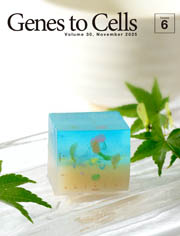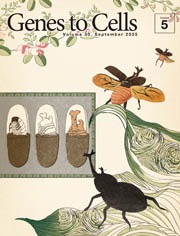
November 2025
2尾の鯉がscRNA-seqの可視化結果で躍動する
When we visualized single-cell RNA sequencing data using UMAP, a pattern serendipitously emerged that resembled two carp ascending a waterfall. We sought to enclose this image within a refreshing Japanese confection. We are grateful to Prof. Fumiki Katsuoka and Dr. Takanori Hidaka (Tohoku University) for providing the idea and the UMAP visualization.
シングルセルRNAシークエンスの結果をUMAPで可視化したところ、偶然にも2尾の鯉が滝を登る姿のような模様が浮かび上がった。これを涼しげな和菓子の中に閉じ込めてみた。アイディアとUMAPによる可視化結果を提供してくださった東北大学の勝岡史城教授と日高高徳博士に感謝申し上げる。

September 2025
カブトムシの角はどのように形作られるのか?
In the larval head of the Japanese rhinoceros beetle (Trypoxylus dichotomus), the horn primordium is stored as a sac-like structure with wrinkles inscribed in a specific pattern. When the larva molts into a pupa, hemolymph is pumped into this sac, causing the wrinkles to stretch and the sac to expand, which results in the formation of the horn. Multiple research groups in Japan have investigated the three-dimensional morphogenesis of this horn. For further information, see the following publications: Matsuda et al. (2024) Development 151: dev202082, DOI: 10.1242/dev.202082; Matsuda et al. (2021) Sci. Rep. 11: 1017, DOI: 10.1038/s41598-020-79757-2; Adachi et al. (2020) Sci. Rep. 10: 18687, DOI: 10.1038/s41598-020-75709-y; Ohde et al. (2018) PLoS Genet. 14: e1007651, DOI: 10.1371/journal.pgen.1007651. As if celebrating the emergence of the beetles, the veins of the nearby leaves trace patterns reminiscent of the wrinkles in the horn primordium.
カブトムシの幼虫の頭部には、特殊なパターンで皺が刻まれた袋のような構造を持つ角の原基が格納されており、蛹への脱皮の際にその中へ体液が送り込まれると、皺が伸びながら袋が膨らみ、角が完成する。この角の三次元の形態形成は日本の複数のグループによって研究されてきた。詳しくは以下の論文を参照されたい:Matsuda et al. (2024) Development 151: dev202082, DOI: 10.1242/dev.202082 ; Matsuda et al. (2021) Sci. Rep. 11: 1017, DOI: 10.1038/s41598-020-79757-2 ; Adachi et al. (2020) Sci. Rep. 10: 18687, DOI: 10.1038/s41598-020-75709-y ; Ohde et al. (2018) PLoS Genet. 14: e1007651, DOI: 10.1371/journal.pgen.1007651 。カブトムシの誕生を祝うかのように、傍らの葉の葉脈が原基の皺の模様を描いている。